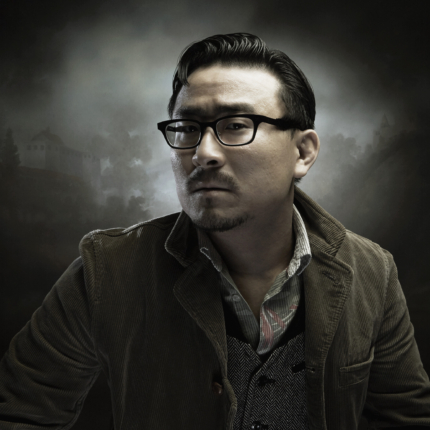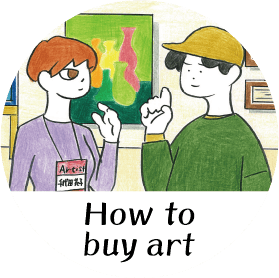Showa Trilogy — 「Showa88 / 昭和88年」「Showa92」「Showa96」
“昭和”が付くからと言って、別だんノスタルジーを追い求めている訳では全くありません。僕は、昭和という言葉を“生き抜く力”の象徴と考えます。
昭和がまだ別の時空で続いていたらどんな世界か。
パラレルワールドとしての現代日本を10年かけて、三冊の写真集にまとめました。
このシリーズは、フィリップ・K・ディックの小説 『高い城の男』 にインスパイアされ、多元宇宙を描いています。平成や令和がおとずれず昭和が続いている現代日本の記録です。この作品は、現実とフィクションがぶつかり合ったときに起る事故のようなものかもしれません。
コンプライアンス時代を生きる現在、どこか自力で生きるという満足感が希薄に感じたことがありました。実体の見えないものに対して自主規制を張ってしまい白か黒か、はっきりさせることが求められているように感じます。
人間にはコンピューターのように 1 か 0 で定義できない複雑さがあり、そのグレーゾーンこそが人間的価値のようにも思います。矛盾を抱えながらもどさくさを必死に凌いで行った昭和的な生き方への憧れからイメージが膨らんで行きました。
このシリーズには「対極の美」というコンセプトがあります。
“猥雑さと崇高さ” “恐怖と滑稽さ” “東洋と西洋” “リアルとフェイク” “生と死” といった二項対立がイメージを支え合いグレーゾーンを作り出しています。また一方で、写真は記録性という役目を持ったメディウムです。失われてゆく文化や、場所を記録するという役目もあります。人間が成長してゆき死を迎えなかったら、街や自然にサイクルがなかったら写真はここまで発達することはなかったでしょう。
今回出品している水色の着物の女性のイメージは、2019年に取り壊された金子國義邸の記録で金子氏が好きだった小村雪岱へのオマージュです。
Showa Trilogy — Showa 88, Showa 92, and Showa 96
‘My use of the word “Showa” in the series’ title should not be misunderstood as my interest in exploiting feelings of nostalgia.
“Showa” to me means “the power to survive.”
What would the world look like if Japan’s Showa era (1926–1989) were still alive today? That’s the fantasy I allowed myself to indulge in three photobooks, the third and final entry having been published at the very end of Japan’s Heisei era (1989–2019).
The Heisei era—written with the two Japanese characters for “peace” and “to become“—truly has become what it promised—an era of peace and quiet. Thanks to the achievements of those who came before us, we in Japan were able to experience a safe period of relative stability.
At the same time, however, the undeniable truth is that behind the abundance of the Heisei era was a constant feeling of unease and uncertainty, a questioning whether “this is truly enough”, if “this is how things should go”. The era lacked any rite of passage to herald adulthood. I, too, was one of those who had to experience these feelings of uncertainty.
Here, we open a hole in the ground and bravely jump in, to arrive in a parallel world where Showa never ended and Heisei never happened.
I have some thoughts regarding today’s age of “compliance”. I believe that contradictions always exist in survival. In order to survive, there are grey zones that we cannot define as black or white. There are complexities in human beings that cannot be defined as “1” or “0” like computers.
For me, the grey zone is what makes us human, and that is exactly what I have been exploring in this trilogy. I find nobility in the indecorousness in my subjects — a form of aesthetics born from one’s strong faith.’
—Kazuyoshi Usui
Born in Tokyo in 1975, Usui joined the Hakuhodo Photo Creative after graduating from the Department of Photography at Tokyo Polytechnic University in 1998 and became an independent photographer in 2013. He has exhibited his works at the exhibition “In & Out” at the Tokyo Metropolitan Museum of Photography (2003), the exhibition “Japan” at the Maymac Contemporary Art Center, France (2014), and Regards Croisés Japon-Provence at France Provence (2015), and participated in art fairs and exhibitions in Japan and abroad, including Gelatin Silver Session (2015, 2017). Winner of the 2006 APA Awards in the Advertising Work category, Usui has published several books including Macaroni Christian (Bijutsu Shuppansha), Showa 88, Showa 92, and Showa 96 (Zen Foto Gallery). Showa 92 was nominated for the 41st Kimura Ihei Award. In 2015 his first film Dalai Lama XIV, shot in close-up over six years, was released and shown throughout Japan, starting with Shibuya Eurospace.
Kazuyoshi Usui’s Showa trilogy is inspired by Philip K. Dick’s novel The Man in the High Castle for its depiction of a parallel reality. His Showa trilogy, which he has been working on for nearly 10 years, is based on places that give a hint of the Showa era, in which he grew up, but is now disappearing. Usui does not work on his own memory but imagines Showa as if the era had continued to the present. He depicts places typical of those to be found in underground or B movies, as well as the marginal people who live there in reality, in their minds, or the photographer’s imagination. The viewer wonders whether the image represents reality or some staged scene. His photographs question the real and the fake. He creates tragicomic, illusory fictions that seem like narratives but are more like legends in which the viewer can choose to create the story that develops in the interstices between the photographs. Usui was inspired by the Japanese painters Kiyokata Kaburagi and Settai Komura for their use of color, as well as by the cinematography of Kazuo Miyagawa (who filmed Rashomon of Kurosawa, winner of the Cannes film festival in 1951) and director John Waters. The concept of opposing beauties (Taikyoku no bi) also permeates the Showa trilogy. Both pairs of dichotomies like “indecency and the sublime,” “terror and the comical,” “Eastern beauty and Western beauty,” and “Life and Death” are embedded in his images. Usui studied under the pioneering photographer Hosoe Eikoh. The influence of Hosoe is visible in Usui’s black and white photographic work, such as Macaroni Christian. Usui originally wanted to become a filmmaker but turned to photography as soon as he started practicing it.
‘In my trilogy, I followed the smell of humanity, that almost repugnant odor, with the camera as my tool. I relied on my own sense of smell; I was led to encounter and photograph all these people and places, and at times I could recreate the stories I felt in the places I visited.
Using photography, a contradictory medium that weaves truths and lies, I tried to capture the heat emitted when people’s projected images and their true selves clash and grind. Perhaps I did it to fill in the gaps of my own dissatisfaction with the Heisei era.
Even if Japan—bleached, sterilized—emits much less of that human smell these days, I will still continue to hunt after it with my camera.’
— Kazuyoshi Usui
Notes
1. A Japanese era name, Showa (1926–1989) spans the period from the coronation of Emperor Hirohito on December 25, 1926, to his death on January 7, 1989.
2. The Heisei era (1989–2019) covers the period from the coronation of Emperor Akihito on January 8, 1989, to his abdication on April 30, 2019.

薄井 一議
Kazuyoshi Usui
1975年 東京生まれ
1998年 東京工芸大学芸術学部卒業
2022年 Photography?end?、POST、東京
2022年 kazuyoshi usui-showa trilogy、IBASHO、アントワープ(ベルギー)
2022年 B/W、Place M Yokohama、神奈川
2020年 L’ANTI CHAMBRE、Alta Volta-La Nouvelle République Hotel、パリ(フランス)
2019年 Les Rencontres de la photographie Marrakech 2019、マラケシュ イヴ サンローラン美術館、マラケシュ(モロッコ)
1975 Born in Tokyo
1998 Graduated from Tokyo Polytechnic University.
2022 Photography?end?, POST, Tokyo
2022 kazuyoshi usui-showa trilogy, IBASHO, Antwerp(Belgium)
2022 B/W, Place M Yokohama, Kanagawa
2020 L’ANTI CHAMBRE, Alta Volta-La Nouvelle République Hotel, Paris(France)
2019 Les Rencontres de la photographie Marrakech 2019, Yves Saint Laurent Museum Marrakech, Marrakech(Morocco)








[推薦者コメント]
薄井さんの作品を初めて見たのは20年ほど前、「マカロニキリシタン」という写真集を発表した時だ。1999年という世紀末の日本にキリストが現れたら、という設定でモノクロで綴られる作品世界に衝撃を受けた。そして写真集のページを最後まで繰った時に感じたのは、デレク・ジャーマンやダリオ・アルジェントの映画を見終えた時のような不条理感と、突きつけられるカント的な美醜の判断。そしてモノクロ写真であるにも関わらず眼前に浮んだ色彩のイマジネーションだった。(20年経った今でも、作家の作品に向き合う度にその感覚は続いている。)
以降のシリーズで、いよいよ薄井さんは「色彩」を手に入れる。今回出品されるシリーズ「Showa Trilogy」は、人々がギラギラとした生命力に充ち満ちていた「昭和」という激動の時代が現代も続いていたら、というある種のパラレルワールドを切り取った作品群である。映画的な物語性をもった架空の世界を作り上げ、シャッターを切っていく創作手法は常に一貫しているが、虚実入り交じった風景の中からは、生々しい生命のリアリズムと生への渇望が、沸々と湧き出ている。そして作品を目前にすると、扇情的とも言える色彩の力に気づくだろう。薄井さんが手に入れた「色彩」は、まさにこの「生命力」の象徴であるに違いない。平成・令和と続くこの時代。閉塞感すら漂う今の時間の中で薄井さんの写真が語りかけることはあまりに多く、ヒリヒリとした刺激と創造性に満ちている。(アーツ千代田 3331 彦根延代)